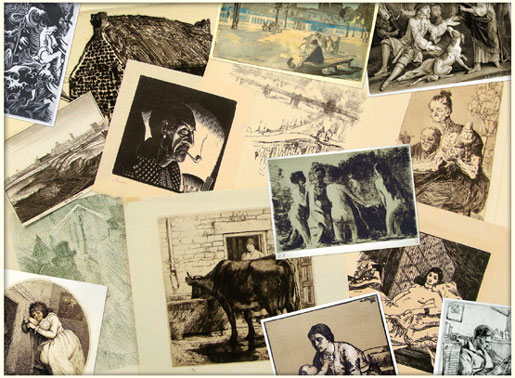The
History and Techniques of Printmaking
An
Introduction
Artists’ printmaking
has a continuous history going back over
six centuries. Some of the world’s
greatest artists have been enthusiastic
printmakers, among them Dürer, Rembrandt,
Claude, Canaletto, Goya, Whistler, Pissarro,
Gauguin and the German Expressionists.
In
parallel, other artists, less emphasized
in the canons of general art history, have
found their primary artistic expression
in graphic art and are equally among the
masters of printmaking, including Callot,
della Bella, Piranesi, Meryon, Goeneutte,
Kollwitz, Shannon, Cameron and Bone.

Although
the origins of printmaking lie in the popular
demand for duplications of holy images
and playing cards, artists soon recognized
not only the commercial potential of multiple
impressions of a single image but the aesthetic
potential of the very specific qualities
of line and surface that only the various
printmaking processes can achieve.
The
very act of printing, the physical transfer
of ink from the design on the matrix to
the image on paper, seems to stamp the
printed image with an enhanced significance.
A reality born out both by photocopying
a casual doodle and by the very existence
of the monotype – a print whose process
determines a single impression only.
The
matrix selected largely determines the
printmaking process to be employed. Traditionally
wood blocks are used to create relief prints
(woodcuts and wood engravings) while metal
plates, usually sheets of copper, are employed
for intaglio prints (etchings and engravings-line,
mezzotint, stipple etc).
From
the end of the 18th century onwards, new
planographic techniques were invented,
principally lithography which utilised
limestone blocks. Other various ‘planographic’ processes
include monotypes (printed from glass or
metal plates), clichés verres as
well as other photographic techniques exploiting
light sensitive papers, and screenprints
(created though collaged elements used
in conjunction with a silkscreen). Today,
zinc, plastic and cardboard sheets equally
serve as matrices in quite a variety of
processes.
The
terminology and technology of printmaking
can initially seem baffling to the uninitiated.
I hope the descriptions of the
different techniques and their history
that I have included here on my website will
open access. However, as in a conjuror’s
performance it is best not to get too bogged
down in how it is done but to enjoy the
result.
The
artist’s work on the matrix is not
an end in itself but the means of creating
the resulting printed image. Each impression
printed is an original (if not a unique)
work of art. |